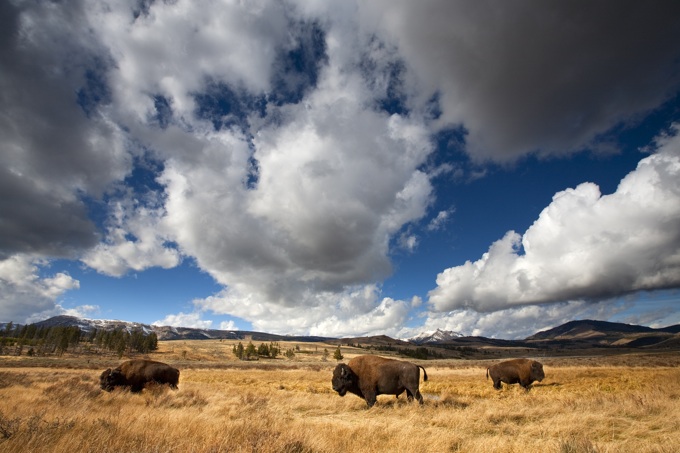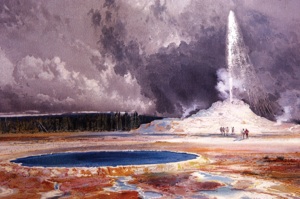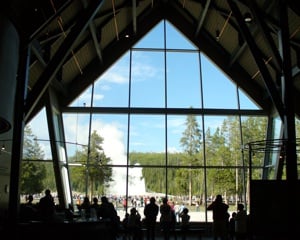
The National Park Service has a great partner in the Yellowstone Park Foundation. Photo copyright by Ian Shive.
Editor's note: Though Yellowstone was the world's first national park, that doesn't mean the National Park Service has all the resources it needs to protect this wondrous place. That's why the Yellowstone Park Foundation works so hard to raise funds to it can help underwrite programs vital to the park's health and the public's enjoyment. In this installment of the Traveler's Essential Friends project, we introduce you to the Foundation and its mission in Yellowstone.
As Congress continues to look for ways to cut federal spending, non-profit organizations such as the Yellowstone Park Foundation are becoming invaluable for the direct funding they provide the national parks. Often without their help trails would go without maintenance, wildlife research would dip, and facilities would deteriorate. Today, social trails that have upset the pristine scenery of campgrounds are being erased, fisheries are being restored, and a world-class visitor education center has arisen near Old Faithful thanks to the Foundation.

Thomas Moran was so awestruck by the beauty and wildness of Yellowstone that he filled sketchbook after sketchbook with images, such as this one of Castle Geyser in the Upper Geyser Basin. His stunning paintings of the Lower Falls of Yellowstone helped convince Congress to designate Yellowstone as a national park. Image via NPS.
In recent years the Foundation has directed $3 million to $5 million each year in funding for a wide variety of park projects, such as wildlife studies and a program to teach visitors how to avoid trouble with wildlife. They provide annual support for the Yellowstone Youth Conservation Corps, a residential work program for teens that integrates stewardship, environmental education, leadership skills, and recreation.
Two particularly noteworthy efforts the Foundation shouldered in recent years were a $15 million campaign to underwrite the new visitor education center at Old Faithful, and a $1 million rehabilitation of historic Artist Point overlooking the Grand Canyon of the Yellowstone.
Some of the Foundation’s work, such as the Old Faithful Visitor Education Center and Artist Point improvements, are highly visible and visitor friendly.
Other projects may not be quite as visible but are equally important and beneficial to the public nonetheless. For instance, the Foundation has raised $2 million to rehab more than 100 miles of hiking trails, provided funds for conservation of the park’s collection of rare art, documents, and specimens, and contributed $170,000 for the first two years of a comprehensive, five-year Yellowstone Raptor Study that will inventory the park’s birds of prey, such as owls and golden eagles.
Contributions large and small combine to fuel the Foundation’s presence in the park. Throughout the year you can help support wildlife research by “adopting” one of Yellowstone’s iconic native species in the form of a plush animal. In return, along with knowing your dollars will support this research, you’ll receive educational materials on the animals as well as a personalized “adoption certificate” that make these pets perfect presents for kids.
Save A Bear
Your dollars also can go to the Foundation’s Sponsor A Bear Box campaign that puts bearproof storage boxes in campgrounds; helps purchase collars that enable researchers to follow wolves through the park; or even supports a program that enlists volunteer anglers to help with monitoring Yellowstone’s fisheries.

“Many people don’t know that there is a way to become directly involved in caring for Yellowstone,” says Karen Bates Kress, president of the Foundation. “We offer a way for individuals, foundations, and corporations to become stewards of Yellowstone.
"As the official fundraising partner of Yellowstone, we offer tools to help people spread the word about donating via our website, such as free e-postcards and a brand new feature where people can become a Yellowstone Park Foundation fundraiser and customize their own fundraising page on our site. Most often, our work is ‘behind the scenes’ in the park. But there are more than three million visitors to Yellowstone each year, and we know there are many more people who would be eager to become involved if they knew about the Yellowstone Park Foundation.”
Working Towards The Future
Looking ahead, the Foundation is concentrating on raising a significant amount of funds over the next several years to support the park’s Native Fish Conservation Program, a vital project in light of the non-native lake trout invasion of Yellowstone Lake, recent years of drought, introduction of disease, and the impact of climate change on the park’s native fish.

The Yellowstone Park Foundation helped underwrite the cost of the Old Faithful Visitor and Education Center. Photo by David and Kay Scott.
Yellowstone’s fisheries extend beyond streams and lakes to affect terrestrial species, such as bears, that rely on the fisheries.
In short, the Yellowstone Park Foundation’s diverse good works aspire to reach as far as this park’s hold on the imagination of the world’s people.
Best Ways To Support the Yellowstone Park Foundation
* Cash contributions of all sizes are greatly appreciated.
* Include the Foundation in your will.
* Collar a wolf. For $2,500 or $5,000 you can put a VHF or GPS collar on one of the park’s wolves for tracking. For $50, you can help contribute to the purchase of a VHF or GPS collar.
* Join the 1872 Society. With annual giving of $1,000 or more your donation can make a long-running difference.
* Adopt some park wildlife. Through the Foundation’s adoption program, your dollars go towards wildlife research, and you get a plush animal in return.
Coming Sunday: Insider tips for enjoying Yellowstone from the Yellowstone Park Foundation.
Coming Next Wednesday: Discriminating Explorer, a collection of great ways to explore the national parks featured in Traveler's Essential Friends.

 Support Essential Coverage of Essential Places
Support Essential Coverage of Essential Places







Comments
I do understand the purpose of charitable foundations, but I also find it very discouraging that their list of things you can do to help only includes monetary gifts of one kind or another.
That's fine for those who can afford it, but what can the rest of us do?
You can volunteer, Meg, but that would require visiting the park, which could cost you more than a donation.
http://www.ypf.org/site/News2?page=NewsArticle&id=5145